



In this post, we walk through a step-by-step process to validate large datasets after migration using PyDeequ. However, developing custom solutions to determine migration accuracy by comparing the data between the source and target can often be time-consuming. This data validation is a critical step and if not done correctly, may result in the failure of the entire project. During data migration, a key requirement is to validate all the data that has been moved from on premises to the cloud. If you're planning a strategy for growth, a robust database system can be your business' most valuable resource.įor more advice on using a database in your business, see the benefits of databases.Many enterprises are migrating their on-premises data stores to the AWS Cloud. Most business databases have some form of reporting capabilities - from analysing input data and productivity tracking, to anticipating future trends and customers' needs. By using an inventory tracking database, especially alongside electronic data interchange and barcode scanning, you can avoid those risks and minimise lost sales while maximising your opportunities for growth. If you're tracking your inventory manually, it's also easy to miscount, make data entry errors or misplace spreadsheets and notes. It's easy to have too much - sitting on a shelf risking wastage, or too little - disappointing your customers and damaging your reputation. Managing your inventory well can occasionally feel like a balancing act. Some CRM systems can even help you run and track marketing campaigns, such as email newsletters. Full-featured CRM databases are usually powerful enough to store and process everything, from customer contact details, interaction history and accounts, to new prospects, leads and business opportunities. If customers are the lifeblood of your business, then a good customer relationship management (CRM) database should be at the heart of your growth plans. This can leave you more time to focus on growing your business. It can streamline most of the HR tasks, automate routine jobs and speed up the processing of data such as staff hours, leave, benefits, payroll, etc. Using an HR database to manage staff records can save you time and money. Better management of human resources (HR) matters Good database systems can help you manage all your business-critical data centrally, safely and securely - whenever you need it - to boost your chances of success. If your business is growing and you have staff to help you run it, keeping track of the increasing amount of data can be tricky. Here's why you should consider replacing spreadsheets with databases to help your business grow.

But if you have lots of data, for example on customers, staff or your inventory, you may benefit from a more efficient data management tool. Spreadsheets are great tools for number crunching.


 0 kommentar(er)
0 kommentar(er)
